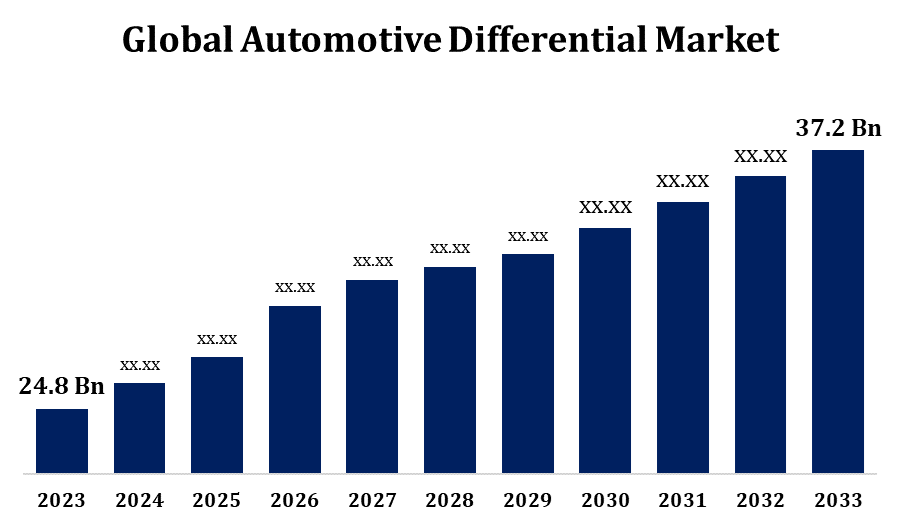Global Automotive Differential Market Size To Worth USD 37.2 Billion By 2033 | CAGR of 4.14%
Category: Automotive & TransportationGlobal Automotive Differential Market Size To Worth USD 37.2 Billion By 2033
According to a research report published by Spherical Insights & Consulting, the Global Automotive Differential Market Size to Grow from USD 24.8 Billion in 2023 to USD 37.2 Billion by 2033, at a Compound Annual Growth Rate (CAGR) of 4.14% during the Forecast period.

Get more details on this report -
Browse key industry insights spread across 230 pages with 110 Market data tables and figures & charts from the report on the "Global Automotive Differential Market Size, Share, and COVID-19 Impact Analysis, By Differential (Open Differential, Limited-Slip Differential (LSD), Electronic Limited-Slip Differential (ELSD), Locking Differential, Torque Differential), By Drive (Front-wheel drive, Rear-wheel drive, All-Wheel Drive (AWD)/Four-Wheel Drive (4WD)), By Propulsion (Engine, Electric), and By Region (North America, Europe, Asia-Pacific, Latin America, Middle East, and Africa), Analysis and Forecast 2023 - 2033." Get Detailed Report Description Here: https://www.sphericalinsights.com/reports/automotive-differential-market
The automotive differential market is experiencing growth driven by rising vehicle production, increasing demand for fuel efficiency, and advancements in drivetrain technology. Differentials are essential for distributing torque between wheels, enhancing traction and stability, particularly in off-road and high-performance vehicles. The market is expanding with the growing adoption of all-wheel-drive (AWD) and four-wheel-drive (4WD) systems in passenger and commercial vehicles. Innovations such as electronic limited-slip differentials (eLSD) and torque vectoring are improving vehicle performance and safety. The Asia-Pacific region leads the market, with rapid urbanization and industrialization boosting demand, especially in China and India. Additionally, stringent emission regulations are encouraging automakers to develop lightweight, energy-efficient differentials. The rise of electric vehicles (EVs) is also shaping differential designs, driving further technological advancements.
Automotive Differential Market Value Chain Analysis
The automotive differential market value chain spans multiple stages, from raw material suppliers to end users. It starts with procuring raw materials, mainly steel and aluminum, for manufacturing differential casings and gears. These materials are then processed into key components like ring gears, pinions, bearings, and housings by manufacturers and suppliers. Original equipment manufacturers (OEMs) integrate differentials into drivetrains, ensuring compatibility with vehicle specifications. Tier-1 and Tier-2 suppliers contribute to innovation by developing advanced technologies such as electronic limited-slip differentials (eLSD). The distribution network includes direct OEM sales and aftermarket suppliers offering replacement parts and performance upgrades. Lastly, automotive service centers, repair shops, and consumers form the final stage. Increasing automation and electrification are transforming the value chain, emphasizing lightweight and high-efficiency differentials.
Automotive Differential Market Opportunity Analysis
The automotive differential market offers substantial growth opportunities, driven by advancements in vehicle technology and the rising demand for sophisticated drivetrains. The increasing adoption of all-wheel-drive (AWD) and four-wheel-drive (4WD) systems in passenger and commercial vehicles is fueling market expansion. Electric vehicles (EVs) are reshaping the industry, with innovations such as e-differentials and torque vectoring systems enhancing efficiency and performance. The growing popularity of off-road and high-performance vehicles further boosts demand. Additionally, the development of lightweight materials and intelligent differentials supports fuel efficiency and aligns with global sustainability initiatives. Emerging markets in Asia-Pacific, particularly India and China, present lucrative opportunities due to rising vehicle ownership and infrastructure growth. The aftermarket segment also holds potential, driven by extended vehicle lifespans and increasing demand for differential replacements and upgrades.
The increasing demand for commercial and heavy-duty vehicles is a major driver of the automotive differential market. As industries like logistics, construction, and mining grow, the need for high-performance trucks and buses rises, driving differential adoption. These vehicles require durable drivetrain systems to manage heavy loads, rough terrains, and long distances, leading to higher demand for advanced differentials such as limited-slip and electronically controlled variants. Additionally, strict emission regulations are encouraging manufacturers to develop lightweight, fuel-efficient differential systems, further propelling market growth. The rise of electric and hybrid commercial vehicles also creates opportunities for innovative e-differentials, improving efficiency and torque distribution. Rapid infrastructure development in emerging economies, especially in Asia-Pacific, is fueling commercial vehicle sales, thereby accelerating the expansion of the differential market.
The automotive differential market encounters several challenges, including high manufacturing costs and complex integration processes. Advanced differentials, such as electronic limited-slip and torque vectoring systems, require sophisticated engineering and costly components, driving up production expenses. Additionally, the growing adoption of electric vehicles (EVs), which often replace traditional differentials with independent wheel drive systems, poses a potential threat to market growth. Strict environmental regulations further pressure manufacturers to develop lightweight, fuel-efficient differentials, increasing R&D costs. Market stability is also impacted by supply chain disruptions, fluctuating raw material prices, and geopolitical uncertainties. Furthermore, the rise of autonomous and connected vehicles necessitates more advanced and intelligent drivetrain systems, requiring continuous innovation and adaptation—an ongoing challenge, particularly for smaller market players striving to remain competitive.
Insights by Drive
The Front-wheel drive (FWD) segment accounted for the largest market share over the forecast period 2023 to 2033. Front-wheel-drive (FWD) systems are widely utilized in passenger cars and compact SUVs due to their efficient space utilization, reduced vehicle weight, and improved fuel economy. The rising production of small and mid-sized vehicles, especially in emerging markets, is driving demand for FWD differentials. Additionally, advancements in differential technology, such as electronic limited-slip differentials (eLSD), enhance traction and stability, increasing their appeal to consumers. Stringent emission regulations are also encouraging automakers to optimize drivetrains for greater efficiency. With ongoing urbanization and rising vehicle ownership, the FWD differential market is poised for growth, particularly in Asia-Pacific and Europe, where demand for fuel-efficient and cost-effective vehicles continues to rise.
Insights by Propulsion
The electric segment accounted for the largest market share over the forecast period 2023 to 2033. Unlike traditional internal combustion engine (ICE) vehicles, many electric vehicles (EVs) utilize independent electric motors for each wheel, reducing the need for conventional differentials. However, the demand for advanced e-differentials, torque vectoring systems, and electronic limited-slip differentials (eLSD) is growing to enhance traction, stability, and energy efficiency. Automakers are also focusing on developing lightweight, high-performance differential solutions to meet strict efficiency and range requirements. The rising adoption of all-wheel-drive (AWD) and performance EVs, particularly in premium and commercial segments, further fuels market growth. As global EV adoption accelerates, differential manufacturers are investing in cutting-edge innovations to remain competitive in this evolving industry.
Insights by Differential
The open differential segment accounted for the largest market share over the forecast period 2023 to 2033. Open differentials are widely used in front-wheel-drive (FWD) and rear-wheel-drive (RWD) vehicles, providing a reliable and efficient solution for standard driving conditions. The growing production of economy and mid-range vehicles, particularly in emerging markets, is driving demand for these differentials. Additionally, automakers are incorporating advanced traction control systems with open differentials to improve performance while keeping costs low. Although advanced differential types such as limited-slip and torque vectoring are gaining traction, open differentials continue to dominate the mass-market segment due to their affordability and ease of maintenance.
Insights by Region

Get more details on this report -
North America is anticipated to dominate the Automotive Differential Market from 2023 to 2033. The region's emphasis on all-wheel-drive (AWD) and four-wheel-drive (4WD) vehicles, especially in off-road and performance segments, drives differential adoption. Additionally, strict fuel efficiency and emission regulations encourage manufacturers to develop lightweight, high-performance differentials. The growing presence of electric vehicles (EVs) is also shaping differential innovation, with automakers investing in e-differentials and torque vectoring solutions. Furthermore, the presence of major OEMs and ongoing advancements in drivetrain technology continue to support market growth.
Asia Pacific is witnessing the fastest market growth between 2023 to 2033. China, India, and Japan play a crucial role in market growth, driven by strong demand for passenger cars, commercial vehicles, and electric vehicles (EVs). The increasing preference for SUVs and off-road vehicles further accelerates the need for advanced differentials, such as limited-slip and torque vectoring systems. Additionally, the region’s focus on fuel-efficient and lightweight drivetrain technologies aligns with stricter emission regulations. The expansion of local manufacturing facilities by global automakers, along with the presence of strong domestic players, continues to strengthen market development.
Recent Market Developments
- In January 2022, Dana Incorporated introduced three new planetary drives with wide ratio ranges, improved power density, and modular designs, enhancing Spicer Torque-Hub compatibility for tracked and wheeled vehicles.
Major players in the market
- ZF Friedrichshafen AG (Germany)
- Eaton (Ireland)
- BorgWarnerInc. (US)
- Schaeffler AG (Germany)
- GKN plc (UK)
- JTEKT Corporation (Japan)
- Dana Limited (US)
- DREXLER AUTOMOTIVE (Germany)
- neapco (US)
Market Segmentation
This study forecasts revenue at global, regional, and country levels from 2023 to 2033.
Automotive Differential Market, Differential Analysis
- Open Differential
- Limited-Slip Differential (LSD)
- Electronic Limited-Slip Differential (ELSD)
- Locking Differential
- Torque Differential
Automotive Differential Market, Drive Analysis
- Front-wheel drive
- Rear-wheel drive
- All-Wheel Drive (AWD)/Four-Wheel Drive (4WD)
Automotive Differential Market, Propulsion Analysis
- Engine
- Electric
Automotive Differential Market, Regional Analysis
- North America
- US
- Canada
- Mexico
- Europe
- Germany
- Uk
- France
- Italy
- Spain
- Russia
- Rest of Europe
- Asia Pacific
- China
- Japan
- India
- South Korea
- Australia
- Rest of Asia Pacific
- South America
- Brazil
- Argentina
- Rest of South America
- Middle East & Africa
- UAE
- Saudi Arabia
- Qatar
- South Africa
- Rest of the Middle East & Africa
About the Spherical Insights & Consulting
Spherical Insights & Consulting is a market research and consulting firm which provides actionable market research study, quantitative forecasting and trends analysis provides forward-looking insight especially designed for decision makers and aids ROI.
Which is catering to different industry such as financial sectors, industrial sectors, government organizations, universities, non-profits and corporations. The company's mission is to work with businesses to achieve business objectives and maintain strategic improvements.
CONTACT US:
For More Information on Your Target Market, Please Contact Us Below:
Phone: +1 303 800 4326 (the U.S.)
Phone: +91 90289 24100 (APAC)
Email: inquiry@sphericalinsights.com, sales@sphericalinsights.com
Contact Us: https://www.sphericalinsights.com/contact-us
Need help to buy this report?